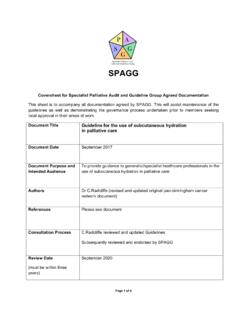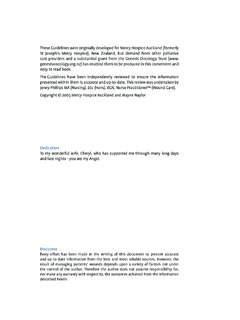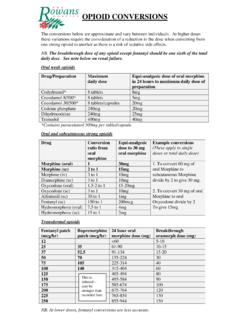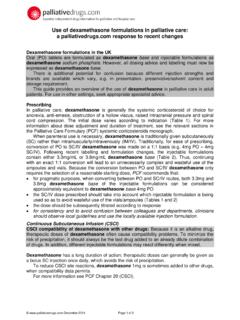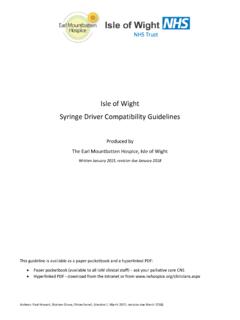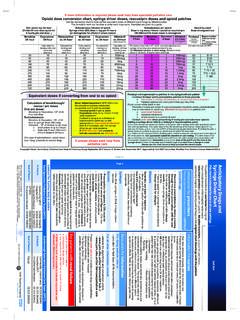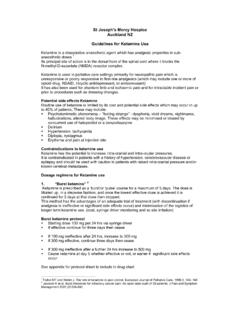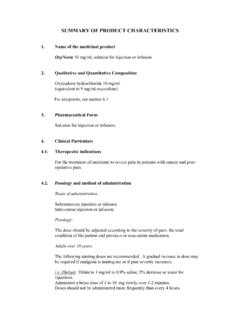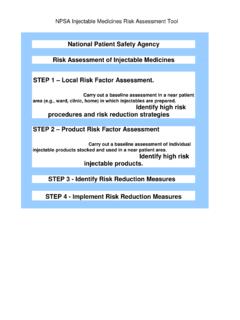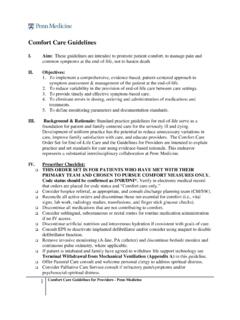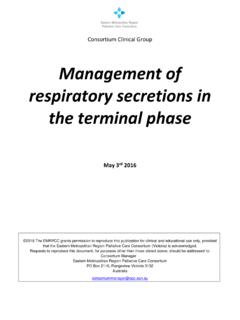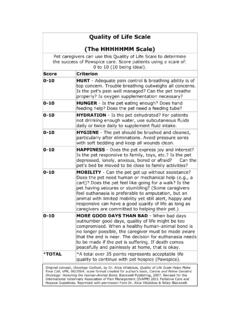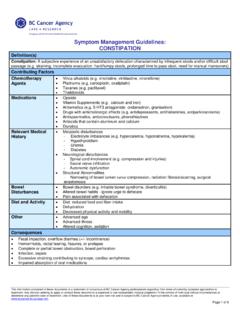Transcription of PALLIATIVE CARE PATIENTS CLINICAL GUIDELINE …
1 Disclaimer: This Document has been developed for Austin Health use and has been specifically designed for Austin Health circumstances. Printed versions can only be considered up-to-date for a period of one month from the printing date after which, the latest version should be downloaded from the 1 of 3 CLINICAL GUIDELINEMANAGEMENT OF TERMINAL RESPIRATORY SECRETIONS IN PALLIATIVE care PATIENTSS taff this document applies to:All CLINICAL Staff of Austin HealthState any related Austin Health policies, procedures or guidelines:Guidelines for care of the Dying PatientSyringe Driver NIKI T34: subcutaneous medication administration PALLIATIVE care Consultancy Service: Referral Guidelines PALLIATIVE care Unit.
2 Admission GuidelinesOncology Unit Protocol ManualClinical Haematology ManualMouth care for Oncology/Haematology PatientsPrinciples of Management:To reduce the impact of excessive oropharyngeal and / or pulmonary secretions in the dying :Terminal respiratory secretions (also known as death rattle ) cause a rattling or gurgling respiratory noise, due to a patient s inability to cough effectively or to swallow and clear secretions from the oropharynx. Family and friends of the dying person may become concerned that the noisy respirations cause the patient : To reduce family/caregiver and staff concerns that death rattle is distressing to the patient To manage/minimise the noisy effect of secretions by utilising nursing and/or pharmacological measuresClinical Alert: Gentle oral suctioning should only be used if effective and tolerated avoid pharyngeal suctioning as this is generally poorly tolerated.
3 If active hydration is provided, it may be contributing to the secretions, and its value should be reviewed by the medical team in consultation with the patient and family. Pharmacological treatment can contribute to the drying of the mouth, and thus there is a need for more frequent mouth Interventions: Explain to the family/caregiver why secretions develop and reassure them that it is a normal part of the dying process and not usually distressing or uncomfortable for the patient. Often repositioning the patient side to side, with the head of the bed slightly elevated, is all that is needed to shift secretions and reduce the No: 2024 Version No: Review Due Date: 3/11/2017 Posted date: 3/11/2014 Downloaded date: 15/12/2014 Disclaimer: This Document has been developed for Austin Health use and has been specifically designed for Austin Health circumstances.
4 Printed versions can only be considered up-to-date for a period of one month from the printing date after which, the latest version should be downloaded from the 2 of 3 If required, anticholinergic drugs should be commenced earlier rather than later, as literature suggests this will improve effectiveness, however recent evidence from a single placebo controlled trial suggests that medication is no better than a placebo. More studies are needed to investigate this further. See table below for information about the usual anti-secretory medications used. The literature reviewed does not show any agent to be more effective than the other.
5 Doses can be titrated according to the patient s response, and can also be given continuously via a syringe DoseRouteFrequencyMax dose/24 mgSubcut2-4 mgHyoscine butylbromide (Buscopan)20 40 mgSubcut2-4 hourly100 mgHyoscine hydrobromide mgSubcut2-4 mgSubcut = subcutaneousNote: Glycopyrrolate and hyoscine butylbromide do not readily cross the blood-brain barrier, and are therefore unlikely to cause or exacerbate Outcome:With appropriate education, nursing measures and pharmacological management, the impact of noisy respiratory symptoms at end of life will be minimised enhancing the potential for a peaceful death.
6 Communication Strategy:All Austin Health Staff - Forward emails to all of the DocumentsEmail to DL Medical Education AllEmail to DL CSU Medical DirectorsNursing DocumentsEmail to DL CNEE mail to DL Nursing GroupAllied Health DocumentsEmail DL Allied Health Austin 5 Author/Contributors:2014 version:Shaun O Neill, CLINICAL Nurse ConsultantIn Consultation With:Dr Juli Moran, Medical Director, PALLIATIVE care Dr Sarah Charlton, PALLIATIVE care Fellow Dr Josephine Stewart, Consultant, Lorraine Jordan, CLINICAL Nurse Consultant Teri Andrew CLINICAL Nurse ConsultantDocument No: 2024 Version No: Review Due Date: 3/11/2017 Posted date: 3/11/2014 Downloaded date: 15/12/2014 Disclaimer: This Document has been developed for Austin Health use and has been specifically designed for Austin Health circumstances.
7 Printed versions can only be considered up-to-date for a period of one month from the printing date after which, the latest version should be downloaded from the 3 of 3 Legislation/References/Supporting Documents: Heisler M et al. Randomized double blind trial of sublingual atropine vs. Placebo for the management of death rattle. J Pain Sympt Manage, in press, 2012 Back, I. N., Jenkins, K., Blower, A., Beckhelling, J., 2001 A Study Comparing Hyoscine Hydrobromide and glycopyrrolate in the treatment of death rattle. PALLIATIVE Medicine. 15: 329 , M., Brennan, M., Hughes, A., O Donnell, V.
8 And Wee, B. 2002 Using Anti-muscarinic Drugs in the Management of Death Rattle: Evidence Based Guidelines for PALLIATIVE care . PALLIATIVE Medicine, 16, 369373 Ellershaw, J. Sutcliffe, J. M. and Saunders, C. M. 1999 Dehydration and the Dying Patient. Journal of Pain and symptom Management. 10:3 192-197 Hugel, H., Ellershaw, M. A. and Gambles, M. 2006 Respiratory Tract Secretions in the Dying Patient: A Comparision between Glycopyrronium and Hyoscine Hydrobromide. Journal of PALLIATIVE Medicine. 9:2 279-284 Kass, R. M. and Ellershaw, J. 2003 Respiratory Tract Secretions in the Dying Patient: A Retrospective Study.
9 Journal of Pain and Symptom Management. 26:4 897-902. Therapeutic Guidelines Limited 2010. Therapeutic Guidelines: PALLIATIVE care (Version 3). North Melbourne, Victoria: Therapeutic Guidelines B, Hillier R. Interventions for noisy breathing in PATIENTS near to death. Cochrane Database of Systematic Reviews , H., and Menten. J. 2002 Death Rattle Prevalence, Prevention and Treatment. Journal of Pain and Symptom Management. 23:4 310-317. Woodruff, R., 2004 4th Edition PALLIATIVE Medicine Evidence-based symptomatic and supportive care for PATIENTS with advanced cancer. Victoria, Australia: Oxford University Press.
10 Eastern Metropolitan Region PALLIATIVE care Consortium (Victoria) Consortium CLINICAL Group End of life care : management of respiratory secretions June 2013 Authorised/Endorsed by:Cancer Services Medical Group Nursing Standards Committee February 2014 Drugs and Therapeutics CommitteeClinical Policies and Procedures CommitteePrimary Person/Department Responsible for Document:Dr Juli Moran, Director of PALLIATIVE care ServicesDocument No: 2024 Version No: Review Due Date: 3/11/2017 Posted date: 3/11/2014 Downloaded date: 15/12/2014
